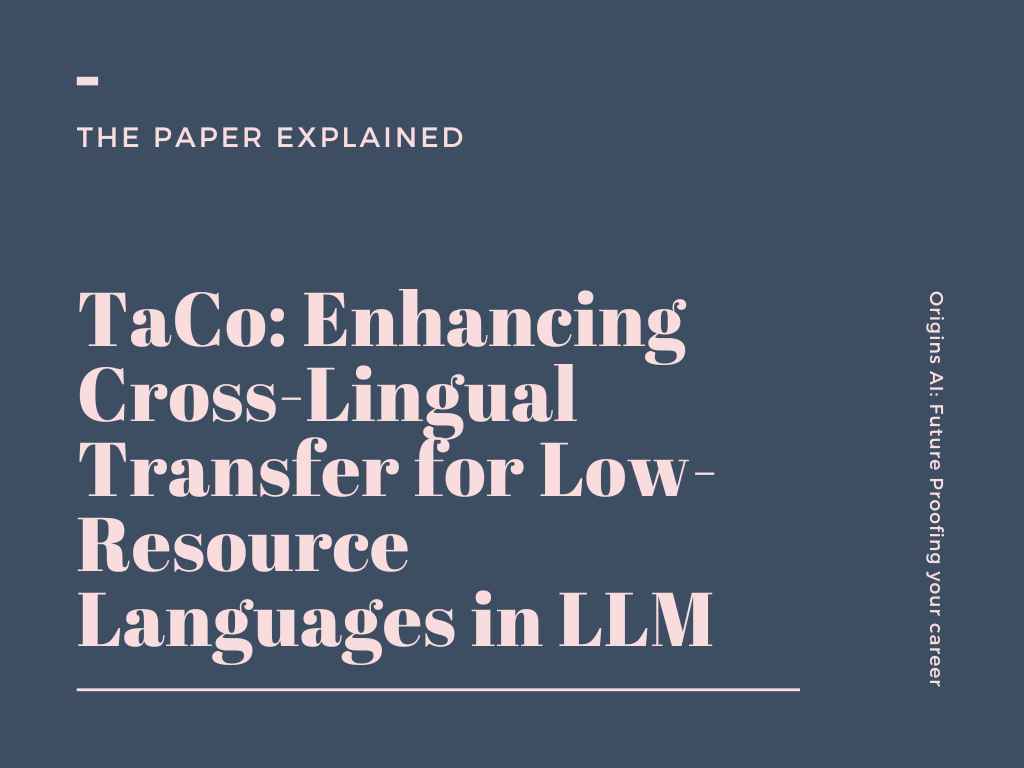The rapid advancement of Large Language Models (LLMs) like ChatGPT and PaLM holds immense potential for revitalizing low-resource languages. However, training these models for new languages, especially those with limited resources, presents significant challenges. This is where TaCo, a novel method proposed by researchers at the University of New Haven, comes into play.
TaCo, short for Translation-Assisted Cross-Linguality, utilizes a clever combination of translation and chain-of-thought processes to efficiently train LLMs on new languages. This blog post delves into the details of TaCo, exploring its approach, datasets, training process, and evaluation results.
The Challenges of Multilingual LLMs
While LLMs have shown impressive capabilities in English and some high-resource languages, extending their prowess to low-resource languages faces several hurdles:
- Data Scarcity: LLMs require vast amounts of training data, which is often unavailable for low-resource languages.
- Costly Training: Pretraining and fine-tuning LLMs for new languages demands significant computational resources, making it impractical for many research groups.
- Curse of Multilinguality: As the number of languages increases, the performance in low-resource languages tends to decline.
TaCo: A Cost-Effective Solution
TaCo tackles these challenges by employing a parameter-efficient fine-tuning approach and leveraging the existing knowledge of LLMs in English. Here’s how it works:
- Multilingual Instruction-Tuning Dataset (MITDS): TaCo utilizes a new dataset called MITDS, which comprises translations of existing instruction-tuning datasets like Alpaca-52K and Dolly-15K into 132 languages.
- Translation-Assisted Chain-of-Thought: TaCo prompts the LLM to follow a chain-of-thought process involving translation. The model first translates the instruction into English, formulates a response in English, and then translates the response back into the target language.
- Curriculum Learning: TaCo adopts a curriculum learning strategy, starting with a pre-trained LLM already proficient in English (e.g., Guanaco-33B) and then fine-tuning it with the TaCo method using Low-Rank Adaptation (LoRA) for parameter efficiency.
This approach offers several advantages:
- Reduced Training Costs: By leveraging existing English language knowledge and LoRA, TaCo significantly reduces the computational cost of training multilingual LLMs.
- Improved Performance: The chain-of-thought process with translation helps the model learn both translation and comprehension of the target language, leading to better performance.
- Multilingual Vicuna Benchmark: The researchers also introduce a multilingual version of the Vicuna Benchmark, translated into 132 languages, to evaluate the performance of TaCo models.
Evaluation and Results
The researchers evaluated TaCo models on the multilingual Vicuna Benchmark for three low-resource languages (Nepali, Sanskrit, and Maithili) and one high-resource language (Persian). The results were impressive:
- TaCo models achieved an average score of 88% for Nepali, 80% for Sanskrit, 82% for Maithili, and 84% for Persian, as judged by GPT-4.
- Compared to conventional instruction tuning without TaCo, the new method yielded almost double the average score, demonstrating its effectiveness.
Discussion and Future Work
TaCo presents a promising approach for developing multilingual LLMs, particularly for low-resource languages. However, the researchers acknowledge certain limitations, such as token limits impacting the length of responses and the model’s dependence on English for creativity. Future work will focus on addressing these limitations and improving the performance of smaller models.
Overall, TaCo’s innovative use of translation and chain-of-thought processes paves the way for more efficient and effective multilingual LLM development, contributing to the preservation and revitalization of low-resource languages.
To read more paper checkout this page

